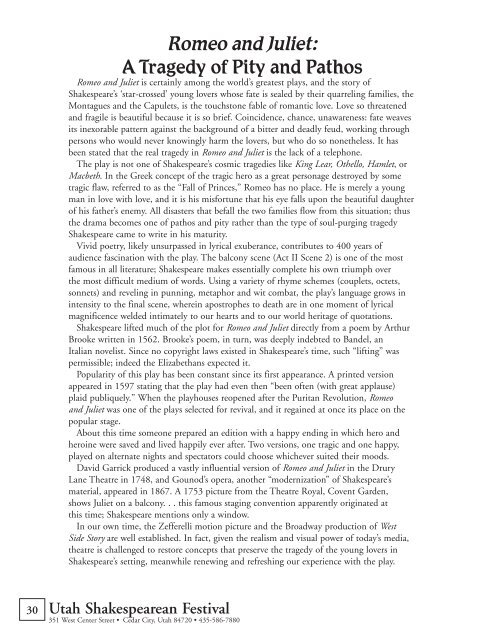Romeo and Juliet - Mr. Robertson's Bunker
Romeo and Juliet - Mr. Robertson's Bunker
Romeo and Juliet - Mr. Robertson's Bunker
You also want an ePaper? Increase the reach of your titles
YUMPU automatically turns print PDFs into web optimized ePapers that Google loves.
<strong>Romeo</strong> <strong>and</strong> <strong>Juliet</strong>:A Tragedy of Pity <strong>and</strong> Pathos<strong>Romeo</strong> <strong>and</strong> <strong>Juliet</strong> is certainly among the world’s greatest plays, <strong>and</strong> the story ofShakespeare’s ‘star-crossed’ young lovers whose fate is sealed by their quarreling families, theMontagues <strong>and</strong> the Capulets, is the touchstone fable of romantic love. Love so threatened<strong>and</strong> fragile is beautiful because it is so brief. Coincidence, chance, unawareness: fate weavesits inexorable pattern against the background of a bitter <strong>and</strong> deadly feud, working throughpersons who would never knowingly harm the lovers, but who do so nonetheless. It hasbeen stated that the real tragedy in <strong>Romeo</strong> <strong>and</strong> <strong>Juliet</strong> is the lack of a telephone.The play is not one of Shakespeare’s cosmic tragedies like King Lear, Othello, Hamlet, orMacbeth. In the Greek concept of the tragic hero as a great personage destroyed by sometragic flaw, referred to as the “Fall of Princes,” <strong>Romeo</strong> has no place. He is merely a youngman in love with love, <strong>and</strong> it is his misfortune that his eye falls upon the beautiful daughterof his father’s enemy. All disasters that befall the two families flow from this situation; thusthe drama becomes one of pathos <strong>and</strong> pity rather than the type of soul-purging tragedyShakespeare came to write in his maturity.Vivid poetry, likely unsurpassed in lyrical exuberance, contributes to 400 years ofaudience fascination with the play. The balcony scene (Act II Scene 2) is one of the mostfamous in all literature; Shakespeare makes essentially complete his own triumph overthe most difficult medium of words. Using a variety of rhyme schemes (couplets, octets,sonnets) <strong>and</strong> reveling in punning, metaphor <strong>and</strong> wit combat, the play’s language grows inintensity to the final scene, wherein apostrophes to death are in one moment of lyricalmagnificence welded intimately to our hearts <strong>and</strong> to our world heritage of quotations.Shakespeare lifted much of the plot for <strong>Romeo</strong> <strong>and</strong> <strong>Juliet</strong> directly from a poem by ArthurBrooke written in 1562. Brooke’s poem, in turn, was deeply indebted to B<strong>and</strong>el, anItalian novelist. Since no copyright laws existed in Shakespeare’s time, such “lifting” waspermissible; indeed the Elizabethans expected it.Popularity of this play has been constant since its first appearance. A printed versionappeared in 1597 stating that the play had even then “been often (with great applause)plaid publiquely.” When the playhouses reopened after the Puritan Revolution, <strong>Romeo</strong><strong>and</strong> <strong>Juliet</strong> was one of the plays selected for revival, <strong>and</strong> it regained at once its place on thepopular stage.About this time someone prepared an edition with a happy ending in which hero <strong>and</strong>heroine were saved <strong>and</strong> lived happily ever after. Two versions, one tragic <strong>and</strong> one happy,played on alternate nights <strong>and</strong> spectators could choose whichever suited their moods.David Garrick produced a vastly influential version of <strong>Romeo</strong> <strong>and</strong> <strong>Juliet</strong> in the DruryLane Theatre in 1748, <strong>and</strong> Gounod’s opera, another “modernization” of Shakespeare’smaterial, appeared in 1867. A 1753 picture from the Theatre Royal, Covent Garden,shows <strong>Juliet</strong> on a balcony. . . this famous staging convention apparently originated atthis time; Shakespeare mentions only a window.In our own time, the Zefferelli motion picture <strong>and</strong> the Broadway production of WestSide Story are well established. In fact, given the realism <strong>and</strong> visual power of today’s media,theatre is challenged to restore concepts that preserve the tragedy of the young lovers inShakespeare’s setting, meanwhile renewing <strong>and</strong> refreshing our experience with the play.30Utah Shakespearean Festival351 West Center Street • Cedar City, Utah 84720 • 435-586-7880
















